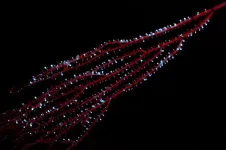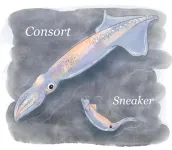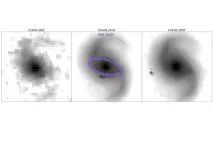(Press-News.org)
Imagine being able to look inside a single cancer cell and see how it communicates with its neighbours.
Scientists are celebrating a new technique that lets them study the fatty contents of cancer cells, one by one.
A study led by the University of Surrey has sampled single live cancer cells and measured the fatty lipid compounds inside them. Working with partners at GSK and UCL, and developing new equipment with Yokogawa, the team saw how those cells transformed in response to changes in their environment.
Dr Johanna Von Gerichten, from Surrey’s School of Chemistry and Chemical Engineering, said:
“The trouble with cancer cells is that no two are alike. That makes it harder to design good treatment, because some cells will always resist treatment more than others.
“Yet it has always proven tricky to study live cells after they have been removed from their natural environment, in enough detail to truly understand their make-up.
“That is why it is so exciting to be able to sample live cells under a microscope and study their fatty contents one by one.”
Individual pancreatic cancer cells were lifted from a glass culture dish using Yokogawa’s Single Cellome System SS2000 ™. This extracts single live cells using tiny tubes 10 µm across – about half the diameter of the thinnest human hair.
By staining the cells with fluorescent dye, the researchers could monitor lipid droplets (stores of fatty molecules inside cells, thought to play an important role in cancer) throughout the experiment.
Then, working with partners at Sciex, researchers developed a new method using a mass spectrometer to fragment the lipids in the cells.This told them about their composition.
The researchers demonstrated that different cells had very different lipid profiles. They also saw how lipids in the cells changed in response to what was going on around them.
Professor Melanie Bailey said:
“We are really excited to work with scientists from all over the UK to apply this to other types of cells, to better understand infection, immunity and other phenomena as part of our new national facility for single and sub-cellular “omics”, SEISMIC, funded by BBSRC and EPSRC.
“We are also part of an International Atomic Energy Agency programme which is exploring the effects of irradiation on cells. We will be working with researchers from all over the world to understand why some cancer cells resist radiation treatment.”
Dr Carla Newman, Associate Director, Cellular Imaging and Dynamics at GSK said:
“Our new method paves the way for studying cancer cells in detail we’ve never seen before.
“One day, we might be able to see how individual cancer cells communicate with their neighbours. That could unlock new, more targeted treatments.
“It’s great to see universities and industry come together to produce such ground-breaking research.”
The study is published in the journal Analytical Chemistry.
ENDS
END
New cancer research made possible as Surrey scientists study lipids cell by cell
2024-04-24
ELSE PRESS RELEASES FROM THIS DATE:
Bioluminescence first evolved in animals at least 540 million years ago
2024-04-24
Bioluminescence first evolved in animals at least 540 million years ago in a group of marine invertebrates called octocorals, according to the results of a new study from scientists with the Smithsonian’s National Museum of Natural History.
The results, published today, April 23, in the Proceedings of the Royal Society B, push back the previous record for the luminous trait’s oldest dated emergence in animals by nearly 300 million years, and could one day help scientists decode why the ability to produce light evolved in the first place.
Bioluminescence—the ability of living things to produce light via chemical reactions—has independently ...
Squids’ birthday influences mating
2024-04-24
The day a male spear squid hatches determines which mating tactic he will use throughout his life, according to new research. Spear squid (Heterololigo bleekeri) that hatch earlier in the season become “consorts” which fight for mating opportunities. Those which hatch later become “sneakers,” which use more clandestine mating tactics. Researchers found that the mating tactic determined by the birth date was fixed for the squid’s whole life. Understanding how mating tactics are influenced by birth date, and the environmental conditions at that time, can help researchers consider ...
Star bars show Universe’s early galaxies evolved much faster than previously thought
2024-04-24
Embargoed until 00:01am BST on Wednesday 24 April 2024/19.01pm ET on Tuesday 23 April 2024
-With pictures-
The Universe’s early galaxies were less chaotic and developed much faster than previously thought, according to new research looking back more than ten billion years in time.
An international team of astronomers led by Durham University, UK, used the James Webb Space Telescope (JWST) to find evidence of bar formation when the Universe was only a few billion years old.
Bars are elongated strips of stars found in disc or ...
Critical minerals recovery from electronic waste
2024-04-24
RICHLAND, Wash.—There’s some irony in the fact that devices that seem indispensable to modern life—mobile phones, personal computers, and anything battery-powered—depend entirely on minerals extracted from mining, one of the most ancient of human industries. Once their usefulness is spent, we typically return these objects to the Earth in landfills, by the millions.
But what if we could “mine” electronic waste (e-waste), recovering the useful minerals contained within them, instead of throwing them away? A clever method of recovering valuable minerals from e-waste, developed by a research team at the Department ...
The move by Apple Memories to block potentially upsetting content illustrates Big Tech’s reach and limits, writes Chrys Vilvang
2024-04-23
How do algorithms determine the way we interact with our memories?
It’s a uniquely 21st-century kind of question, and it is far from settled.
In a new paper in the journal Memory, Mind & Media, Concordia PhD candidate Chrys Vilvang argues that the way tech companies store, package and share personal content back to users is opaque. And, given one recent controversy, it’s open to important questions about selection and representation.
Vilvang’s paper looks at the discussion stemming from an April 2022 article on 9to5Mac, a tech news site dedicated to all things Apple. Its journalists were given access to the iOS 15.5 beta update, and they discovered ...
Chemical tool illuminates pathways used by dopamine, opioids and other neuronal signals
2024-04-23
Image
University of Michigan researchers have developed a new tool to better understand how chemicals like dopamine and epinephrine interact with neurons.
These chemicals are among a wide variety of signals that get processed in the brain through G protein-coupled receptors (GPCRs), proteins that sit on the surface of neurons to receive messages—in the forms of proteins, sugars, fats, even light—that inform cellular behavior.
GPCRs are involved in an enormous number of biological functions, making them a prime ...
Asian monsoon lofts ozone-depleting substances to stratosphere
2024-04-23
Asian monsoon lofts ozone-depleting substances to stratosphere
Airborne observations discover new link between pollution and climate
Powerful monsoon winds, strengthened by a warming climate, are lofting unexpectedly large quantities of ozone-depleting substances high into the atmosphere over East Asia, new research shows.
The study, led by the U.S. National Science Foundation National Center for Atmospheric Research (NSF NCAR) and NASA, found that the East Asian Monsoon delivers more than twice the concentration of very short-lived ozone-depleting substances into the upper troposphere and lower stratosphere than previously reported.
The research team ...
PET scans reveal ‘smoldering’ inflammation in patients with multiple sclerosis
2024-04-23
A Brigham and Women’s Hospital study of 30 people found that, in patients with MS, advanced brain imaging could identify hidden inflammation not picked up on traditional MRIs
The new technique could lead to more advanced treatments for multiple sclerosis
A new study from Brigham and Women’s Hospital, a founding member of the Mass General Brigham healthcare system, suggests positron emission tomography (PET) brain scans could reveal hidden inflammation in patients with multiple sclerosis (MS) who are being treated with highly-effective treatments. The findings were published ...
Genetics predict type 2 diabetes risk and disparities in childhood cancer survivors
2024-04-23
(MEMPHIS, Tenn. – April 23, 2024) Survivors of childhood cancer are at increased risk for cardiovascular disease, for which a risk factor is their greater prevalence of type 2 diabetes, with a disproportionate impact on those of non-European heritage. St. Jude Children’s Research Hospital scientists have identified four previously unknown genetic variants associated with diabetes risk in all survivors. Published today in the Journal of Clinical Oncology, their work also found an association between a previously ...
Health information on TikTok: The good, the bad and the ugly
2024-04-23
In today's digital age, social media platforms like TikTok have become integral parts of our lives, offering not just entertainment and catchy dances but also a wealth of information on topics ranging from home improvement to world news. According to some reports, many young people even prefer to use social media in place of traditional search engines like Google when looking for answers.
Health information is no exception. Hashtags like #celiactok, #diabetestok and #sinustok have millions of views, with each tag leading to countless videos about each health issue.
“Every type of ‘Tok’ exists – that’s just ...





